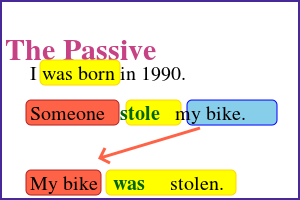Passive/Passive Present Perfect: Unterschied zwischen den Versionen
(+Vorlage:Passive) Markierung: Quelltext-Bearbeitung 2017 |
Markierung: Quelltext-Bearbeitung 2017 |
||
| Zeile 29: | Zeile 29: | ||
</div> | </div> | ||
{{Fortsetzung|vorherlink=Englisch/Grammatik/Passive/ | {{Fortsetzung|vorherlink=Englisch/Grammatik/Passive/Mixed Exercises|vorher=Mixed Exercises| | ||
übersicht=The Passive<br>(Overview)|übersichtlink=Englisch/Grammatik/Passive| | übersicht=The Passive<br>(Overview)|übersichtlink=Englisch/Grammatik/Passive| | ||
weiter=Passive Present Progressive|weiterlink=Englisch/Grammatik/Passive/Passive Present Progressive | weiter=Passive Present Progressive|weiterlink=Englisch/Grammatik/Passive/Passive Present Progressive | ||
Version vom 7. April 2019, 11:50 Uhr
Im Present Perfect besteht das Verb im Passiv aus drei Bestandteilen:
have / has been
(Form von "to be") past participle (3.Form)
Interactive exercises
The classroom
Put in the verbs in the passive form. The sentences are all in present perfecrt!
1. All classrooms have been cleaned(clean) by the pupils.
2. But in one classroom two chairs have been damaged (damage).
3. A test has been stolen (steal) from one of the desks.
4. The cheater has been caught(catch) by the teacher.
Christmas
Put in the verbs in the passive form. The sentences are all in present perfecrt!
1. Have you ever been given(give) a nice present for Christmas?
2. Look! The window has been broken (break).
3. The window hasn't been repaired (not, repair) yet.




